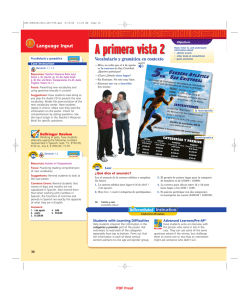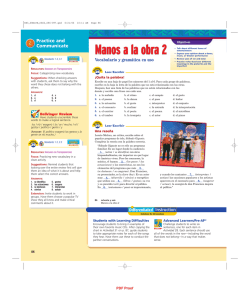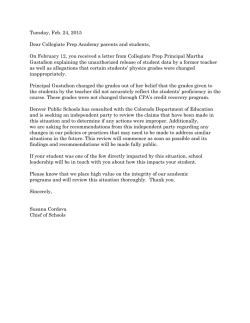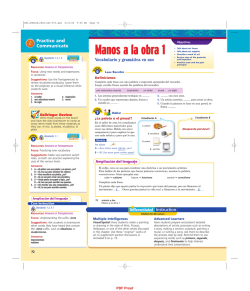
Practice and Communicate
RE3_08NLTE_FM_xxxiv-15.qxd 6/29/06 10:37 AM Page 2 Practice and Communicate Objectives • Talk about your daily routine jed-0099 • Discuss school and extracurricular activities Tu vida diaria Core Instruction Standards: 1.2 Resources: Voc. and Gram. Transparency 23; Teacher’s Resource Book: Input Script, p. 6, Audio Script, p. 8; Audio Program: Track 1 Focus: Reviewing daily routines and pastimes Suggestions: After students have read the conversations, focus on the activities mentioned by saying them aloud and having volunteers pantomime the actions. Bellringer Review —Hago la tarea por la tarde, antes de ayudar a mi mamá con los quehaceres de la casa. —Hago la cama, tomo el desayuno, pongo los libros en la mochila y salgo de casa a las 7:30. —¿Cómo ayudas a tu mamá? Suggestions: Have students write down words and phrases to answer the questions. Have them use these notes as they answer orally in complete sentences. Answers: 1. Ana hace la cama, toma el desayuno, pone los libros en la mochila y sale de casa. 2. Su actividad favorita es jugar al fútbol. 3. A veces va al gimnasio con sus amigos. 4. Hace su tarea. 5. Dicen que él cocina muy bien. —Hmm, . . . A veces voy con mis amigos al gimnasio a hacer ejercicio. —Voy al supermercado con ella y la ayudo a cocinar. Me encanta hacer la cena y todos en mi familia dicen que cocino muy bien. tivid 1 Leer/Hablar Cada día Contesta las preguntas sobre Ana y Tomás. 1. ¿Qué hace Ana por la mañana? 4. ¿Qué hace Tomás antes de ayudar a su mamá con los quehaceres de la casa? 5. ¿Qué dicen en la familia de Tomás acerca de cómo cocina él? 2. ¿Cuál es la actividad favorita de Ana? 3. ¿Adónde va a veces Tomás? ¿Con quién? tivid ad Common Errors: Students may forget to change first-person forms to the thirdperson when answering. Model correct verb forms as necessary and have students repeat. —Juego al fútbol . . . mi actividad favorita. ad Focus: Demonstrating reading comprehension ad Ac —¿Y cuándo haces la tarea? —¿Qué haces generalmente por la mañana, antes de salir para la escuela? Ac ANSWERS Resources: Answers on Transparencies tivid —¡Por supuesto! —¿Y en tu tiempo libre? Standards: 1.1, 1.2 1 —Hola Tomás, ¿puedes contestar unas preguntas sobre lo que haces después de la escuela? Ac tivid ad Ac Show Voc. and Gram. Transparency 23. Have students mention activities that Ana and Tomás do daily. —Hola, Ana. Tengo que escribir un artículo para la revista de la escuela sobre la vida diaria de los estudiantes. ¿Puedes responder a unas preguntas? 2 Escribir Tu vida diaria ¿Qué haces durante el día? Completa las frases con lo que haces en un día típico. 1. Voy . . . 2. Hago . . . 2 3. Tomo . . . 4. Juego . . . 5. Pongo . . . 6. Salgo . . . 7. Miro . . . 8. Ayudo . . . 9. Estudio . . . 10. Escucho . . . dos Tu vida diaria Standards: 1.3 2 Focus: Practicing daily-routine and pastime vocabulary Suggestions: Encourage students to include details, such as times and descriptive adjectives, in their answers. Answers will vary. 2 Multiple Intelligences Advanced Learners Bodily/Kinesthetic: Have students group themselves, pantomime an action, and conjugate one verb accordingly. For example, one student pantomimes and says: Yo tomo el desayuno. Another joins him or her and they say: Nosotros tomamos el desayuno. Another addresses them and says: Uds. toman el desayuno, and so on. Have students interview a classmate on the subject of his or her daily activities on a typical day. Then ask them to convert the interviewee’s answers to the third-person and present an oral report of the person’s typical day. RE3_08NLTE_FM_xxxiv-15.qxd 6/21/06 9:17 AM Page 3 Practice and Communicate Verbos irregulares Remember that some verbs in Spanish are irregular in the first person singular of the present tense. Look at the following examples. Note that other verbs you know that are conjugated like conocer are obedecer, ofrecer, and parecer. conocer dar hacer poner saber salir traer ver caer conozco doy hago pongo sé GRAMMAR Core Instruction Resources: Voc. and Gram. Transparency 24 salgo traigo veo caigo Suggestions: Conduct a rapid interchange, moving through the class with questions to which students invent answers on the spot: —María, ¿de dónde sales por la mañana? —Salgo de la casa. —Pedro, ¿de dónde sale María? —Sale de la casa. —¿Y tú? ¿De dónde sales por la tarde? —Salgo de la escuela. —Y Pedro, ¿qué pones en la mochila? —Pongo mis libros. Also, there are some verbs in Spanish that are irregular in all the persons of the present tense: ir decir soy somos voy vamos digo decimos eres sois vas vais dices decís es son va van dice dicen estar oír tener estamos oigo oímos tengo tenemos estás estáis oyes oís tienes tenéis está están oye oyen tiene tienen tivid ad estoy Ac ser Standards: 1.1 3 tivid ad Ac Focus: Practicing verbs that are irregular in the first person 3 Suggestions: Have students conduct the activity twice, switching roles, so that each partner can practice the first-person forms. Hablar ¿Qué haces tú? Answers will vary. No todas las personas hacen las mismas actividades durante el día. Trabaja con otro(a) estudiante para hablar sobre las actividades que hacen usando los verbos del recuadro. Usen ¿qué?, ¿cómo?, ¿cuándo?, ¿dónde?, ¿para qué?, ¿a qué hora?, ¿por qué? para hacer las preguntas. Extension: Ask students questions about their partner’s activities, and then about their own: —Belinda, ¿qué dice Tomás sobre la tarea? —Tomás hace su tarea después de la cena. —¿Y tú? ¿Cuándo haces tu tarea? —Yo hago mi tarea antes de la cena. Modelo A —¿A qué hora desayunas? B —Yo desayuno a las ocho de la mañana. comer estudiar ir al gimnasio ver la tele salir de paseo ir de compras hacer la tarea hacer/practicar un deporte hablar por teléfono tomar el desayuno ir a la escuela llegar tomar (lecciones) navegar en la Red Teacher-to-Teacher tres Para empezar 3 Enrich Your Teaching Resources for All Teachers Culture Note Teacher-to-Teacher In most places in Latin America, school sports are not as heavily funded and organized as they are in United States schools. However, this doesn’t mean young people there don’t play league sports. Rather, sports enthusiasts belong to neighborhood teams sponsored by local merchants or parents’ organizations. Time pair work and group work activities with a kitchen timer. When the alarm sounds, stop the activity, address any questions students may have, and move on. Timed activities will help you greatly in designing and sticking to your lesson plans. Have students socialize on the first day of class by interviewing four classmates. Ask them to find out the names, ages, favorite classes, and favorite activities of the people to whom they speak. Encourage students to take notes. Call on volunteers to report their findings to the class. Additional Resources WAV Wbk.: Audio Act. 1, p. 1 Teacher’s Resource Book: Audio Script, p. 8 • Audio Program: Track 2 • • 3 RE3_08NLTE_FM_xxxiv-15.qxd 6/29/06 10:38 AM Ac tivid ad Practice and Communicate Page 4 4 jed-0099 Leer/Escuchar tivid ad Ac Elena y su familia Standards: 1.2 4 ANSWERS Resources: Teacher’s Resource Book: Audio Script, p. 8; Audio Program: Track 3; Answers on Transparencies Lee la siguiente descripción de Elena de los quehaceres que hace cada miembro de su familia. En mi familia todos ayudamos con los quehaceres de la casa. Cada uno de nosotros tiene una tarea específica. Como nuestros horarios son diferentes, nunca estamos todos trabajando al mismo tiempo. Las tareas que tenemos son: Focus: Practicing daily-routine vocabulary Suggestions: Before playing the Audio CD for Step 2, ask questions with quién: ¿Quién corta el césped? Have students respond with complete sentences. Answers: 1. F 2. F 3. F 4. F 5. C 6. F Mamá: • preparar el almuerzo • limpiar la cocina y el baño • lavar la ropa Yo: • arreglar mi cuarto y hacer la cama • dar de comer al perro • poner la mesa Papá: • hacer el desayuno • cortar el césped • lavar el coche Mi hermano mayor: • preparar la cena • arreglar su cuarto y hacer la cama • pasar la aspiradora Como todos ayudamos con los quehaceres, las tareas se hacen más rápido y tenemos más tiempo libre para salir a pasear o hacer otras actividades. Standards: 1.1, 1.3 Ac Focus: Practicing daily-routine vocabulary Suggestions: Encourage students to use Elena’s account in Actividad 4 as a model for their own accounts of household chores. Standards: 1.1, 1.3 6 Focus: Practicing daily-routine vocabulary Suggestions: Point out to students that they should concentrate on verbs involved in performing the activity, in order to adequately describe it. For lavar el coche, for example, suitable verbs might be llenar or usar. Answers will vary. 5 Escribe una breve descripción sobre quiénes hacen los quehaceres en tu casa y qué hace cada uno. Escribe la información en forma de frase. Trabaja con un(a) compañero(a) para comparar las descripciones que escribieron. Decidan qué actividades tienen en común y por qué. tivid 6 Escribir/Hablar Tu actividad favorita Decide cuál es tu actividad favorita del día y descríbela. No digas qué actividad es. Modelo Leo mis libros y escribo cosas. Más práctica Practice Workbook, p. 1: P-1 ● Guided Practice: Grammar Acts., pp. 5–6 ● WAV Wbk.: Writing, p. 1 ● Real. para hispanohablantes, pp. 2–3 ● For: Irregular Verbs Web Code: jed-0001 En grupo, cada uno(a) lee su descripción. El resto debe adivinar de qué actividad se trata. Modelo Tu actividad favorita es hacer la tarea. 4 4 Escribir/Hablar En tu familia ad tivid ad Ac Answers will vary. tivid ad 5 Ac tivid ad Ac Escribe los números del 1 al 6 en una hoja. Escucha las frases y escribe C si la frase es cierta y F si es falsa. cuatro Tu vida diaria Students with Learning Difficulties Advanced Learners Have students work with partners who are kinesthetic learners. The partners can pantomime doing household chores while students name the chore being pantomimed. Have students with cameras create photo essays of people, preferably their families, doing household chores. Each picture of a chore should be accompanied by a one-sentence caption saying who is doing the chore. RE3_08NLTE_FM_xxxiv-15.qxd 6/21/06 9:17 AM Page 5 Practice and Communicate Presente de los verbos con cambios de raíz Remember that in Spanish there are three groups of stem-changing verbs. The stem change occurs in all forms except the nosotros(as) and vosotros(as) forms. Here are the present-tense forms of perder (ie), poder (ue) and pedir (i). ➔ ie) poder (o pedir (e Core Instruction ➔ i) Resources: Voc. and Gram. Transparency 25 pierdo perdemos puedo podemos pido pedimos pierdes perdéis puedes podéis pides pedís pierde pierden puede pueden pide piden Other verbs like poder are: jugar (u → ue), contar, costar, encontrar, recordar, volar, dormir, volver, devolver, acostarse, almorzar. Suggestions: Ask students to write sentences that contain two verbs from each of the three lists in the Gramática. Tell them not to use nosotros or vosotros forms. Other verbs like pedir are servir, repetir, reír, sonreír, seguir, vestirse. ad Suggestions: Remind students to pay attention to the subject of each sentence before they write their answer. Leer Lee lo que escribió Carmen sobre su equipo de fútbol. Completa el párrafo con la forma correcta del verbo apropiado en el presente. Answers: 1. prefiero 2. jugamos 3. piensa Ac ad tivid Escribir tivid ad Ac Después de la escuela yo ___ 1___ . (preferir / dormir) ir al club para jugar al fútbol. Mis compañeras y yo ___ 2___ . (recordar / jugar) bastante bien pero nuestra entrenadora ___ 3___ . (poder / pensar) que el equipo rival ___ 4___ . (empezar / jugar) mejor. A veces nosotras ___ 5___ . (perder / servir) un partido, pero cuando nuestro equipo ___ 6____ . (poder / comenzar) meter un gol es fabuloso. 4. juega 5. perdemos 6. puede Standards: 1.3 8 Focus: Practicing verbs with stem changes in the present tense Actividades de la semana Usa los verbos del recuadro para completar las frases según tu experiencia. servir dormir ANSWERS Focus: Practicing verbs with stem changes in the present tense Vida deportiva 8 Standards: 1.2 7 Resources: Answers on Transparencies tivid 7 tivid ad Other verbs like perder are: empezar, querer, preferir, pensar, divertirse, despertarse, sentirse, mentir, cerrar, comenzar, entender. Ac ➔ ue) Ac perder (e GRAMMAR querer poder perder sentirse Suggestions: Encourage students to refer as often as necessary to the verb conjugations in the Gramática while they complete the activity. jugar preferir 1. Después de la escuela, mis amigos . . . 4. Cuando mi equipo favorito . . . 2. Para el almuerzo, mi mamá . . . 5. Muchas veces yo . . . pero no . . . Answers will vary. 3. A veces, mis amigos y yo . . . Additional Resources WAV Wbk.: Audio Act. 2, p. 2 Teacher’s Resource Book: Audio Script, pp. 8–9 • Audio Program: Track 4 • cinco Para empezar 5 • Enrich Your Teaching Resources for All Teachers Teacher-to-Teacher Have students get acquainted with the book at the outset of the school year. Make a list of features for students to find as quickly as they can. These might include: maps of the Spanishspeaking world, English-Spanish and SpanishEnglish vocabulary lists, a ¿Recuerdas? box, a Go Online feature, a Repaso section, the first Lectura, and so on. Have students write down the page numbers of the various features. This could be done as a whole-class activity or as a race between groups of students. 5 6/21/06 9:17 AM tivid ad Practice and Communicate Page 6 Ac RE3_08NLTE_FM_xxxiv-15.qxd 9 Leer/Escribir tivid ad Ac Roberto y Lucas Standards: 1.2, 1.3 9 Imagina que conoces a dos hermanos muy diferentes entre sí (from each other). Observa las fotos y lee el texto que las acompaña. Roberto y Lucas son hermanos. Ellos son muy diferentes entre sí. Los fines de semana, Roberto empieza el día temprano; duerme solamente hasta las siete de la mañana. A las ocho, juega al fútbol con sus amigos y a las diez vuelve a casa. Lucas prefiere levantarse tarde porque se acuesta muy tarde. No entiende cómo su hermano puede levantarse temprano. A Lucas le gusta tocar la guitarra y escribir canciones. Sonríe mucho cuando escucha música, porque le encanta. Cuando Lucas toca la guitarra muy alto (loudly), Roberto se vuelve loco. Lucas se vuelve loco cuando Roberto enciende la luz y lo despierta. A los dos hermanos les gusta ir al cine y navegar en la Red. Los dos son muy amables pero no se entienden muy bien. Focus: Practicing review vocabulary and structures via reading and response Common Errors: Some students may forget to make the spelling changes when they use forms of verbs that have them. Point out that the spelling changes affect the pronunciation of the forms as well. Model correct pronunciation where the spelling changes occur. Have students repeat, or correct their spelling if the error was written. Suggestions: Help students focus on the content of the reading by having them copy the chart to their own paper before they read. Answers will vary. Ac ad tivid Standards: 1.3 10 tivid 10 Actividad jugar al fútbol tocar la guitarra sonreír al escuchar música preferir levantarse tarde encender la luz temprano Modelo Escribir ¿Y qué haces tú? Imagina que estás en una reunión de amigos y comienzan a hablar de lo que hacen. Escribe frases usando las palabras de las tres columnas. Modelo yo / cortarse / el pelo Yo me corto el pelo todos los meses. A yo tú Carlos nosotros ustedes mis amigos Focus: Using new vocabulary and structures in sentences B ayudar correr desayunar hacer salir tomar C autobús de paseo en el parque quehaceres tarea de la escuela temprano / tarde Más práctica Practice Workbook, p. 2: P-2 ● Guided Practice: Grammar Acts., pp. 7–8 ● WAV Wbk.: Writing, p. 2 ● Real. para hispanohablantes, p. 4 ● Suggestions: Point out to students that they can skip around when choosing their cues. They don’t have to use the cues in a straight, horizontal line. Answers will vary. Roberto Lucas Yo Lucas y yo preferimos más escuchar música que hacer deportes. ad Write logical sentences by unscrambling these words and conjugating the verb appropriately. 1) una ensalada/preferir/mis amigos/para el almuerzo 2) ocho horas/dormir/mi hermanito/todos los días 3) a veces/arroz con pollo/servir/mi mamá ¿Eres más similar a Roberto o a Lucas? Indica con una X quién hace cada una de estas actividades y si tú también las hace. Luego, Ac Bellringer Review Roberto o Lucas. 6 For: Stem-changing Verbs Web Code: jed-0002 seis Tu vida diaria Block Schedule ••• •• • • • • • • • • • • • After students have written their paragraphs, put them in pairs. Have each student exchange paragraphs. The partner is to write six Cierto/Falso statements about the information. Each student reads the statements to the partner who will agree or correct the incorrect information. 6 Students with Learning Difficulties Students with Special Needs Help students orientate themselves when using the chart in Actividad 9. Slide your finger across the first row of the chart and explain that all the information in that row has to do with playing football. Repeat this procedure for each row of the chart. Provide hearing-impaired students with a seat near the speakers, or with headphones if possible, whenever conducting recorded listening activities. RE3_08NLTE_FM_xxxiv-15.qxd 6/21/06 9:17 AM Page 7 Practice and Communicate Los verbos reflexivos To say that people do something to or for themselves, you use reflexive verbs. A reflexive verb has two parts: a reflexive pronoun (me, te, se, nos, os) and a verb form. Here are all the present-tense forms of levantarse: me levanto nos levantamos te levantas os levantáis se levanta se levantan GRAMMAR Core Instruction Resources: Voc. and Gram. Transparency 26 Suggestions: Use the reflexive verbs in sentences about what you are going to do tomorrow. Have students respond by saying that they perform the action every day. —Mañana, voy a despertarme a las seis y media. —Yo me despierto a las seis y media todos los días. Pantomime the action for each sentence, and have students do likewise when they respond. Many reflexive verbs in Spanish describe daily routine actions: acostarse (ue), afeitarse, arreglarse, bañarse, cepillarse, despertarse (ie), ducharse, lavarse, pintarse, ponerse, secarse, vestirse (i). Except for se, the reflexive pronouns are the same as the indirect object pronouns. They usually come before the verb, but they may also be attached to an infinitive. Me lavo la cara. Voy a lavarme la cara. Me pongo la chaqueta. Ac Me cepillo los dientes. tivid Standards: 1.3 ad Remember that with reflexive verbs, you usually use the definite article with parts of the body or articles of clothing. 11 ANSWERS Focus: Practicing reflexive verbs tivid ad Ac Resources: Answers on Transparencies 11 Suggestions: Point out to students that for this activity, all reflexive pronouns should precede the verb. Escribir Lo opuesto a ti Imagina que tienes hermanos(as) muy diferentes a ti. Lo que a ti te gusta hacer, a ellos(as) no. Escribe frases comparándose. Answers: Family members will vary. Students will use the following verb forms (with singular subjects). Modelo secarse el pelo Mi hermana no se seca el pelo antes de salir de la casa pero yo sí. 5. despertarse 3. vestirse con ropa moderna 6. acostarse Ac 2. cepillarse los dientes 12 tivid 4. se corta 5. se despierta 6. se acuesta Standards: 1.1, 1.3 12 tivid ad Ac 4. cortarse el pelo todos los meses ad 1. lavarse la cara 1. se lava 2. se cepilla 3. se viste Focus: Practicing reflexive verbs Escribir Más práctica Practice Workbook, p. 3: P-3 ● Guided Practice: Grammar Acts., pp. 9–10 ● WAV Wbk.: Writing, p. 3; p. 6 ● Real. para hispanohablantes, p. 5 ● A las 7:00 . . . Describe lo que haces cada mañana desde que abres los ojos hasta que sales para ir a la escuela. For: Reflexive Verbs Web Code: jed-0003 Modelo 7:00: Me despierto. 7:05: Me levanto de la cama. siete Para empezar 7 Suggestions: Have students prepare by first listing all their morning activities. Suggest that they refer to the Gramática for reminders. Then have them convert their list into a final draft that includes the times and complete sentences. As they make their final draft they can include other activities that they may have forgotten in their lists. Answers will vary. Enrich Your Teaching Resources for All Teachers Additional Resources WAV Wbk.: Audio Act. 3, p. 3 Teacher’s Resource Book: Audio Script, p. 9, Communicative Activity BLM, p. 10 • Audio Program: Track 5 • Teacher-to-Teacher Conduct an information exchange. Prepare a worksheet with students’ names in the left column and in the right column a list of daily activities with their times of day, such as almorzar a la una. Give each student a slip of paper with a daily activity and time from the right column of • the worksheet written on it. Have students complete the worksheet by circulating around the room and asking each other questions about the right column: ¿Tú almuerzas a la una? The first to match all the names and daily activities on his or her worksheet wins. Assessment • • • Prueba P-1, pp. 8–9 Alternate Assessment: Prueba P-1, pp. 1–2 7
© Copyright 2024



